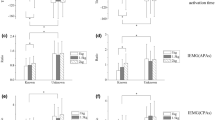Abstract
Many studies have reported postural control against support surface translation. However, postural control mechanism against external force perturbation is not clear. Therefore, in this study we investigated the postural recovery against external force (1∼4Kg) applied to the high-back in health young male subjects (24±4 years). Kinematic data and center of pressure of the reaction to an unexpected perturbation were analyzed. Experimental results showed that the hill-lifting strategy with ankle plantarflexion and knee hyperextension was used in all subjects, regardless of the force magnitude. Specifically, maximum ankle plantarflexion and hip flexion increased with the perturbation force magnitude, the heel vertical excursion and anterior COP excursion. The results of this study show that the postural control strategy for the external force perturbation is quite different from that for surface translation and needs further investigation.
Similar content being viewed by others
References
Kim, B. J. and Robinson, C. J., “Postural control and detection of slip/fall initiation in the elderly population,” Ergonomics, Vol. 48, No. 9, pp. 1065–1085, 2005.
Liu, W., Kim, S. H., Long, J. T., Pohl, P. S. and Duncan, P. W., “Anticipatory postural adjustments and the latency of compensatory stepping reactions in humans,” Neuroscience letters, Vol. 336, No. 1, pp. 1–4, 2003.
Masud, T. and Morris, R. O., “Epidemiology of falls,” Age and Ageing, Vol. 30, Vol. 4, Suppl. 4, pp. 3–7, 2001.
Winter, D. A., Patla, A. E., Prince, F., Ishac, M. and Gielo-Perczak, K., “Stiffness control of balance in quiet standing,” J. of Neurophysiol., Vol. 80, No. 3, pp. 1211–1221, 1998.
Gage, W. H., Winter, D. A., Frank, J. S. and Adkin, A. L., “Kinematic and kinetic validity of the inverted pendulum model in quiet standing,” Gait and Posture, Vol. 19, No. 2, pp. 124–132, 2004.
Morasso, P. G. and Schieppati, M., “Can muscle stiffness alone stabilize upright standing?,” J. of Neurophysiol., Vol. 82, No. 3, pp. 1622–1626, 1999.
Morasso, P. G. and Sanguineti, V., “Ankle muscle stiffness alone cannot stabilize balance during quiet standing,” J. of Neurophysiol., Vol. 88, No. 4, pp. 2157–2162, 2002.
Hill, K., Schwarz, J., Flicker, L. and Carroll, S., “Falls among healthy, community-dwelling, older women: a prospective study of frequency, circumstances, consequences and prediction accuracy,” Aust. N. Z. J. of Public Health, Vol. 23, No. 1, pp. 41–48, 1999.
Bergland, A., Jarnlo, G. B. and Laake, K., “Predictors of falls in the elderly by location,” Aging Clin. Exp. Res., Vol. 15, No. 1, pp. 43–50, 2003.
Bath, P. A. and Morgan, K., “Differential risk factor profiles for indoor and outdoor falls in older people living at home in Nottingham, UK,” Eur. J. of Epidemiol., Vol. 15, No. 1, pp. 65–73, 1999.
Maki, B. E., Holliday, P. J. and Topper, A. K., “A prospective study of postural balance and risk of falling in an ambulatory and independent elderly population,” J. of Gerontol., Vol. 49, No. 2, pp. M72–84, 1994.
Runge, C. F., Shupert, C. L., Horak, F. B. and Zajac, F. E., “Ankle and hip postural strategies defined by joint torques,” Gait and Posture, Vol. 10, No. 2, pp. 161–170, 1999.
Horak, F. B. and Kuo, A. D., “Postural adaptation for altered environments, tasks, and intensions: in Biomechanics and neural control of posture and movement: Section 5,” Springer, pp. 267–281, 2000.
Park, S., Horak, F. B. and Kuo, A. D., “Postural feedback responses scale with biomechanical constraints in human standing,” Exp. Brain Res., Vol. 154, No. 4, pp. 417–427, 2004.
Alexandrov, A. V., Frolov, A. A., Horak, F. B., Carlson-Kuhta, P. and Park, S., “Feedback equilibrium control during human standing,” Biological Cybernetics, Vol. 93, No. 5, pp. 309–322, 2005.
Laessoe, U. and Voigt, M., “Anticipatory postural control strategies related to predictive perturbations,” Gait and Posture, Vol. 28, No. 1, pp. 62–68, 2008.
Burleigh-Jacobs, A., Horak, F. B., Nutt, J. G. and Obeso, J. A., “Step initiation in Parkinson’s disease: influence of levodopa and external sensory triggers,” Mov. Disord., Vol. 12, No. 2, pp. 206–215, 1997.
Horak, F. B. and Diener, H. C., “Cerebellar control of postural scaling and central set in stance,” J. of Neurophysiol., Vol. 72, No. 2, pp. 479–493, 1994.
Johansson, R., Magnusson, M. and Akesson, M., “Identification of human postural dynamics,” IEEE Trans. Biomed. Eng., Vol. 35, No. 10, pp. 858–869, 1988.
Krebs, D. E., McGibbon, C. A. and Goldvasser, D., “Analysis of postural perturbation responses,” IEEE Trans. Neural Syst. Rehabil. Eng., Vol. 9, No. 1, pp. 76–80, 2001.
Mille, M. L., Rogers, M. W., Martinez, K., Hedman, L. D., Johnson, M. E., Lord, S. R. and Fitzpatrick, R. C., “Thresholds for inducing protective stepping responses to external perturbations of human standing,” J. of Neurophysiol., Vol. 90, No. 2, pp. 666–674, 2003.
Author information
Authors and Affiliations
Corresponding author
Rights and permissions
About this article
Cite this article
Kim, J., Kim, C., Lee, J. et al. Human postural control against external force perturbation applied to the high-back. Int. J. Precis. Eng. Manuf. 10, 147–151 (2009). https://doi.org/10.1007/s12541-009-0083-3
Received:
Accepted:
Published:
Issue Date:
DOI: https://doi.org/10.1007/s12541-009-0083-3




